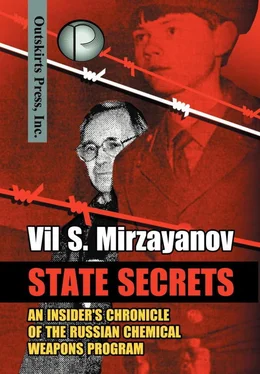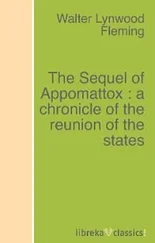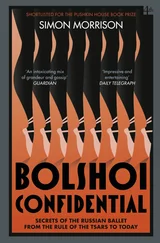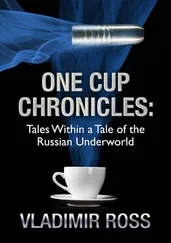Of course I was literally shaken when I heard about Bogomazov’s research results for the first time. His discovery would render any person helpless – whether he was a soldier or an innocent civilian. Being sensitive by nature, I was tormented at that moment by the vision of children meeting their painful deaths in gas masks, which became absolutely useless against a chemical weapons attack, thanks to Bogomazov’s discovery.
We discussed the details of my transfer into the department, and talked about my American instruments, which Dubov had managed to wangle away from Beresnev for my work. We also talked about the possibility that I would finally be able to defend my doctoral thesis, but I could not recover from the shock of what I had heard.
Sometime later, I went to lunch with the young genius and some of his colleagues, and I couldn’t help asking Yevgeny how he felt about it. What if his discovery was ever used against peaceful civilians?
He replied he realized that he might be prosecuted by an international tribunal, as the Nazi war criminals at the Nuremberg trials had been. However, he said, he was only a scientist who had had a great bit of luck. I noticed an undisguised smugness and some kind of bragging on his plump face, probably caused by the presence of Galina Beletskaya, a pretty young laboratory assistant.
By that time, I had almost grown accustomed to shocking talk in some of the seminars run by my colleagues. For example, if they described the lethal properties of some newly synthesized compound as LD 50 (50-percent lethal intravenous dose), that meant that no less than 50 percent of the laboratory animals had to die during tests. I saw rabbits in their agonizing death throes in the test chambers at Department MB. Even after all of that, this young man’s obvious cynicism truly stunned me. I understood at once that we would never be on good terms.
However, despite my feelings and my private suffering over this, I had to do the work that I was assigned. I almost never had any assistants in my new department, so I had to do absolutely everything with my own hands. That was according to the wishes of the young genius. Certainly, that meant a lot of routine and unskilled work, but I didn’t have any choice. I patiently set up my chromatographs and assembled an experimental dynamic set for adsorption analysis.
By the winter of 1982, I already completely understood the uselessness of chemical weapons for our national defense. Even worse, I was convinced that they were directed at the helpless civilian population in the first place. I knew from the press that there were ongoing discussions and negotiations in Geneva for a treaty that would ban the development and production of chemical weapons. But wasn’t it strange that the new project we were developing would mean a new and dramatic turn for the worse in the chemical weapons race?
Since our military-chemical complex had big plans for developing new methods of breaking through the gas-mask filter, a special interdepartmental council was created for discussions and for coordinating the research related to that. Academician Lieutenant General Ivan Knunyants, a well-known military chemist, was appointed the head of this group.
Once I happened to be present at one of the meetings of that council. I was listening to the reports and papers delivered that morning, and I realized that they weren’t up to the job. They seemed like a bunch of dilettantes. I told Bogomazov about my misgivings, and as a result they stopped inviting me to the meetings.
While I was busy setting up my equipment, I was able to observe Bogomazov’s colleagues at work. Zalepugin and Dmitriev toiled selflessly, testing everything new and every new chemical compound that came in from the synthesis laboratories.
Soon they discovered that the selenium analogs of soman and sarin, synthesized by Dr. Evgeni Greenshtein’s group, could also break through the gas-mask filter. It looked like we would soon be able to meet the demand of the Directorate of the Chief of the Chemical Troops (UNKhV) to reduce the initial concentrations of aerosolized chemical agents to less than a few hundredths of a milligram per liter of air. For some reason the military authorities were stuck on the idea that this concentration of chemical agents would be economically “efficient” for killing soldiers on the battlefield, and those in the command stations and gas-protection chambers.
Meanwhile, I began modeling all the stages of the experiment to study the “breakthrough” effect, as Bogomazov had requested. From my previous experience, I knew only too well that technologists often underestimate the importance of choosing the right analytical method, and of using highly skilled personnel for tests. I decided to look into the analytical process control in much more detail.
At first glance, it looked like everything was being done well enough. Gas samples were taken from the adsorption tube outlet that modeled a gas-mask filter, with a special gas-tight syringe. Then, the samples were analyzed in a Tsvet-100 chromatograph with a flame-ionization detector. There was an instrument that recorded the chromatograms, and the results showed a number of so-called peaks corresponding to different compounds. The distance of the interval from the start point of the chromatogram to the peak is a characteristic parameter of each compound. So once you have measured this interval for each compound (in its pure form or mixed with an inert gas), it can be used for the identification of peaks in chromatograms of unknown mixtures, in order to determine the composition of the mixture.
This is the theory and it’s a good one, but in practice everything is much more complicated. Very often a sample contains some additional compounds, which can give the same or nearly identical peak intervals in the chromatogram. When a chromatographic analysis is being conducted using a nonselective flame-ionization detector, the probability of error is rather high, due to several overlapping chromatographic peaks of the organic compounds. It should be said that really experienced specialists almost never used these intervals, because the recorders couldn’t move the paper tape at a constant rate. Instead, real specialists used a stop-watch to time the emerging chromatographic peaks (measurement was taken at the maximum value), and they got much more precise and reliable measurements. Modern devices now take highly precise measurements automatically, with the help of computers.
Once I suggested to Aleksander Dmitriev that we use a stop-watch during the experiments. The first result showed chromatograms with registered peak times for various samples of soman. Then, for comparison, we took the same measurements on the same chromatogram using a mixture of inert nitrogen and the thionic analog of soman.
It turned out that the peak time of the compound emerging from the dynamic adsorption set, which Sasha believed to be the peak of the thionic analog, did not coincide with the peak of the same analog in nitrogen. The difference was very significant and it left no doubt that these peaks belonged to different organic molecules.
It quickly became clear to me that we were dealing with a fundamental error. However, my discovery didn’t make any impression on the MACD graduate, because he was coached to trust only his boss.
I didn’t know whether or not he reported our results to his scientific boss, but I was preparing to analyze the same samples in a Perkin Elmer GC with a flame photometric detector. Deep down inside, I was already sure that all those folks who had made this sensational discovery were in for a huge disappointment. Even though this could adversely affect my career and complicate my doctoral dissertation work, I was thrilled to realize that this terrible menace to people was not real.
Читать дальше












